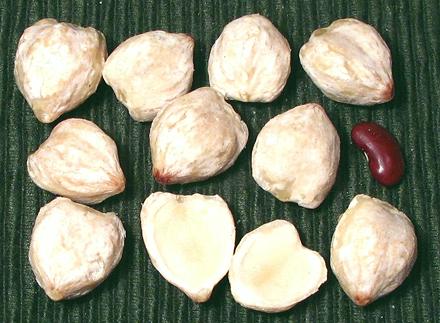
Kukui nut (Hawaii); Indian Walnut; Buah keras (Malay); Kemiri (Indonesia); Lumbang (Philippine); Aleurites moluccana]
Nuts of a tree native to Southeast Asia, and spread by humans to the extent its true origin can not be determined. Polynesian settlers brought it to Hawaii where it became very important - the nuts for food and the rest of the tree for wood, dye, tanning chemicals, medicines and flowers for leis.
Unshelled nuts take a gem-like polish and are used to make bead necklaces. As Kukui, it is the state tree of Hawaii.
Candlenuts are mildly toxic raw and sometimes used as a purgative. Shelled nuts are a bit larger than shelled macadamia nuts and have a softer, lumpier appearance. The largest photo specimen was 1 inch long, 7/8 inch across and 5/8 inch thick, typically 10 to the ounce. While shelled Macadamia nuts (completely unrelated) are often used as a substitute, the flavor is considerably different, though the oil content is similar. As a nut, the macadamia is quite superior. Raw Brazil nuts are probably a superior substitute, but they are not generally available raw in North America.
Today candlenuts are most noted for use as a thickener in the cuisines of Malaysia, Indonesia and surrounding regions. They are available in some Asian markets but should be purchased with caution and used soon as they go rancid rather quickly. Commercially they are most used for production of oil (nuts are 15% to 20% oil) for use in skin care products, but most of the oil is used locally rather than exported.
sumber dari: clovegarden.com